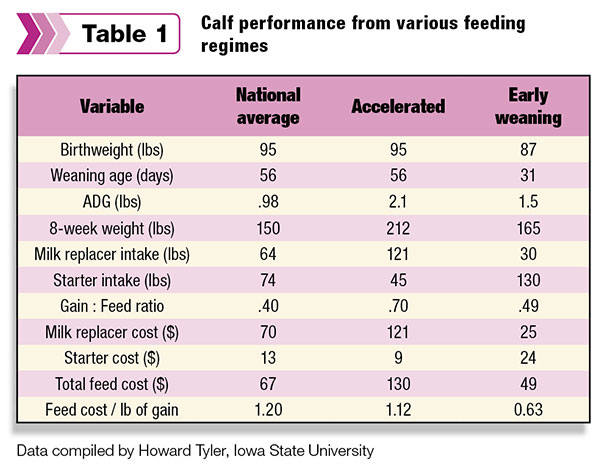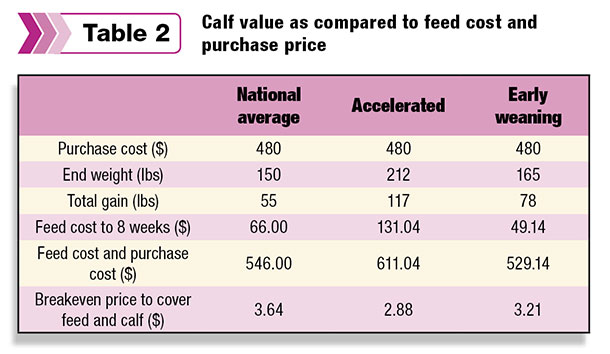Dairy steers contribute 15 to 20 percent of the fed beef market in the U.S. The economic variables that affect profitability of feeding Holstein steers from 6 months old to finish are similar to those of feeding beef cattle.
However, profitably feeding Holstein bull or steer calves from birth to 6 months old is more complicated. While the supply of Holstein bull calves has been fairly stable over the past few decades, demand has been erratic, as indicated by the value of newborn calves.
Economic variables that have the greatest influence on profitability in the feedlot industry include purchase and selling prices and the cost of feed.
Variables such as performance indicators and health status can have severe negative impact on profitability in the feedlot; however, trying to improve profits by improving growth, efficiency and health of these animals has smaller influence than previously discussed variables.
Animal performance of cattle in the feedlot is relatively consistent and must be at an acceptable level for cattle feeders to be profitable.
Dairy calves being raised to 6 months old can have highly variable levels of animal performance. Much of the variability of growth rates and feed efficiency can be attributed to the health status of calves. Newborn calves are highly vulnerable to sickness, and most management strategies should be directed toward calf care and keeping them healthy.
All farmers producing food for consumers should have a commitment to the quality of the final product they produce and understand the impact their management has on that final product. Utilizing the Beef Quality Assurance (BQA) is an ideal mechanism to develop management techniques to ensure the production of high-quality beef.
Beef producers across the country have embraced BQA and implemented proper management techniques to improve profitability. The BQA program covers all aspects of management including animal health.
The veterinarian-client-patient relationship (VCPR) should be a vital part of any animal health management regime. Several factors are critical in the implementation of a VCPR:
- Veterinarian assumes responsibility of clinical judgments of patient, and client agrees to follow veterinarian’s instructions.
- Veterinarian has sufficient knowledge of patient.
- Veterinarian is available for follow-up evaluation.
- Veterinarian provides oversight of treatment, compliance and outcome; patient records are maintained.
Veterinarians should be used to develop preventive health care protocols rather than just being called for emergency situations. Preventive health care practices are critical. Sanitation and ventilation, along with deep straw bedding, are important factors to ensure calves have a comfortable environment with fresh air free from drafts.
Vaccination is also important and should be designed with the assistance of a veterinarian. Care should be taken to minimize stress during castration and dehorning, and steer calves should be implanted with a growth promotant to increase weight gain and feed efficiency.
Dairy bull calf sales account for 1 to 2 percent of gross sales on most dairy farms. Because this number is so low, some dairy farmers see little incentive to care for the bull calves with the same level of care as their heifer counterparts. Calf-raisers buying male calves should discuss with dairy farmers the care bull calves receive at birth.
Colostrum is as important to the male calves as the females. During the first few hours of life, only air is more important to calves than colostrum. Calves that do not receive enough high-quality colostrum to receive adequate Immunoglobulin (Ig) transfer have high mortality and morbidity.
Feeding bull calves conventionally typically involves mixing 0.5 to 1 pound of a 20-20 milk replacer powder with 2 quarts of water and feeding twice daily until weaned at 8 weeks old. Producers should understand that this provides significantly less nutrition than the calf would naturally consume were it able to nurse ad libitum like a beef calf would be able to.
Sucking calves will consume 16 to 24 percent of their bodyweight on a liquid basis of milk that is 27 percent protein and 30 percent fat. Feeding a conventional regime provides 10 percent of the bodyweight for an 80-pound calf – but only 8 percent for a 100-pound calf.
Under ideal conditions, calves can grow at acceptable rates at a feeding rate of 10 percent – but with little margin for unfavorable conditions associated with cold, stress or sickness.
Most of the nutrients under this feeding method are used for maintenance with little energy and protein available for growth. Consequently, conventional feeding offers a less efficient nutrient utilization than could be possible with an accelerated feeding program.
Many heifer-growers have implemented accelerated feeding to achieve higher growth rates while improving calf health. There are many versions of the accelerated program that include increasing consumption by twofold to 2.5-fold and may increase protein content of milk replacer powder ranging from 22 to 26 percent.
Some milk replacers have decreased fat content to 15 percent. Feeding regimes using higher-volume consumption of milk replacer with higher protein concentrations can lower fat content of the powder without sacrificing lean tissue gain or hindering consumption of starter grain mix.
Accelerated feeding programs increase calf growth, improve feed efficiency and usually improve health status of the calf. They will also increase feed costs, but those costs should be offset with improved performance, especially given the current value of weaned calves.
Another feeding regime includes milk replacer feeding with strong encouragement of starter grain mix consumption within a few days. The key aspect to developing an early weaning program revolves around rumen development through the consumption of grain.
Grain consumption for three weeks allows for rumen development to a point that allows calves to be weaned onto a grain starter mix by 4 weeks old. Weaning can occur once calves are consistently consuming 1.5 to 2 pounds of grain mix per day, which is usually between 4 and 6 weeks old.
Research data compiled by Howard Tyler from Iowa State University found in Table 1 shows a comparison of calf performance under three different feeding regimes. This article assumes that most of the national data falls under a conventional feeding system. The data indicates that the cost of gain is lower using an early weaning system at $0.63 per pound of gain.

The accelerated feeding system has much higher feed costs associated with it than the other two systems; however, the improved performance offers an advantage over the national average. Table 2 applies economic value to the performance data and indicates that the accelerated feeding programs are more profitable than the other two systems, followed by the early weaning program.

Management of calves is critical regardless of feeding regime. Calves should have access to water within a couple days of birth. Calves need 4 pounds of water per pound of dry feed consumed. Limiting water will limit starter feed consumption.
Starter grain mix must be accurately formulated at 18 to 22 percent protein and be in a highly palatable form. The mix should be in pellet form or coarsely ground. Care should be taken to ensure particle size is correct. If grain is processed with too small of particles, intake will be reduced.
Once calves are weaned, the ration should be similar to the starter grain mix. Calves should be fed a high-grain ration up to 3 months old to continue rumen development. After that, steer calves should be transitioned toward the type of diet they are likely to encounter at later stages of life.
Steers destined for a corn pellet ration to finish should continue on a high-concentrate ration. Steers that will be transitioned to a higher-fiber diet, such as a grazing system or corn silage ration, can begin inclusion of fiber up to about 50 percent of the ration. Steers need to continue receiving grain in the ration up to 6 months old to fully develop the rumen for efficient fiber digestion. PD
Frank Wardynski is a ruminant educator with Michigan State University Extension. He can be contacted by email.






